To master ancient Chinese tea blending, you need to grasp the balance of flavors, herbs, and proportions. Start with a solid base tea like green or black, and blend in complementary herbs like ginger for spice or chrysanthemum for floral notes. A common ratio is 70% tea to 30% additives, but don't hesitate to experiment with ratios until you find your perfect blend. Pay attention to how flavors interact, ensuring they harmonize. Keep notes on successful combinations for future reference. Uncovering more about blending techniques and seasonal inspirations will deepen your understanding of this flavorful tradition.
History of Chinese Tea Blending
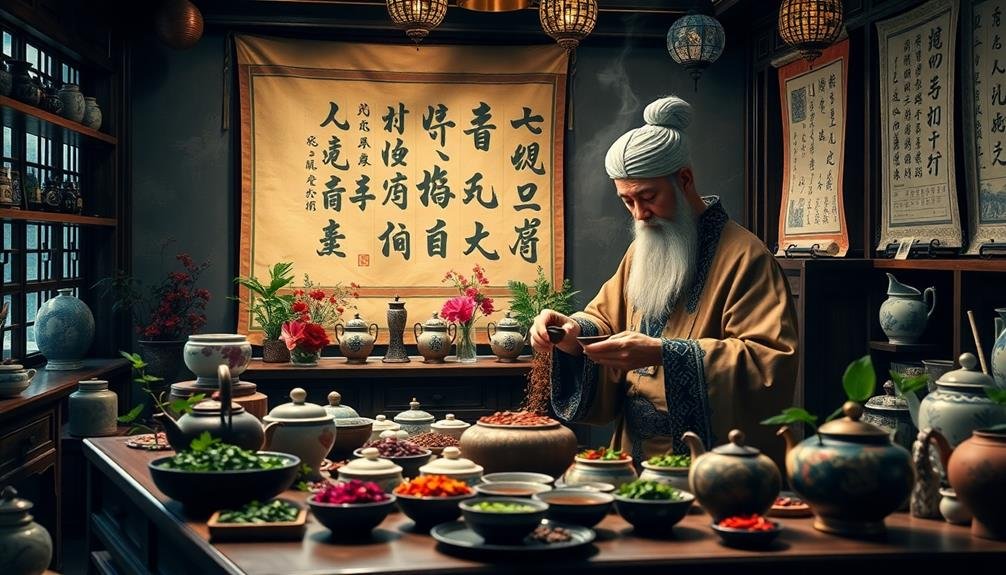
Chinese tea blending has roots that stretch back thousands of years, intertwining with the rich tapestry of Chinese culture. As you explore this ancient practice, you'll discover it flourished during the Tang Dynasty, where tea began to transform from a simple beverage to an art form. Blending various teas became a way to enhance flavors and create unique experiences, reflecting the preferences of the time.
During the Song Dynasty, the focus on tea appreciation deepened, and blending techniques evolved. You'll find that tea masters experimented with different leaves and ingredients, seeking balance and harmony in each cup. This period set the foundation for blending practices that are still cherished today.
As you investigate the Ming and Qing Dynasties, you'll see further innovations, with tea blending becoming a symbol of social status and sophistication. Blending not only created delightful flavors but also served as a means of connecting with others.
In your journey through the history of tea blending, you'll appreciate how each era contributed to the rich legacy that influences modern tea culture. Embracing this history will inspire your own blending adventures and deepen your connection to this time-honored tradition.
Essential Herbs for Blending
When blending tea, the choice of herbs is essential to achieving the perfect flavor and health benefits.
You'll discover key herbal ingredients that enhance your blends and their unique flavor profiles.
Understanding these elements will help you create delicious and beneficial tea combinations.
Key Herbal Ingredients
Blending tea is an art that thrives on the careful selection of key herbal ingredients, each contributing unique flavors and health benefits.
To create a harmonious blend, you'll want to focus on several essential herbs that complement each other while enhancing the overall experience.
Here are three key herbal ingredients you should consider:
- Ginger: Known for its warming properties, ginger adds a spicy kick and is excellent for digestion and boosting immunity.
- Chrysanthemum: This flower brings a delicate floral note and is often used for its cooling effects, making it perfect for balancing stronger flavors.
- Goji Berries: These bright red berries introduce a subtle sweetness and are packed with antioxidants, offering a nutritious boost to your blend.
Flavor Profiles Explained
Understanding flavor profiles is essential for crafting a successful tea blend. Each herb you choose contributes unique taste characteristics that can elevate your creation. Start with the basics: sweet, bitter, sour, and umami. For instance, licorice root adds a natural sweetness, while chrysanthemum flowers introduce a floral note that can soften the overall blend.
Next, consider the bitterness of herbs like dandelion root or pu-erh tea. These can provide depth and balance, countering the sweetness and creating a well-rounded flavor.
Sour notes, which can be found in lemongrass or hibiscus, offer a revitalizing contrast that brightens your blend.
Umami, often overlooked, can be achieved with ingredients like mushrooms or certain seaweeds. This savory aspect enhances the complexity of your tea.
When combining these flavors, aim for harmony. A balanced blend might include a sweet base, a hint of bitterness, a touch of sourness, and a whisper of umami.
Health Benefits Overview
Creating a well-rounded tea blend isn't just about flavor; it's also about harnessing the health benefits of essential herbs.
When you incorporate specific herbs into your tea, you can target various health concerns while enhancing your overall well-being. Understanding these benefits allows you to craft blends that not only taste great but also support your health goals.
Here are three essential herbs to evaluate for your blends:
- Ginger: Known for its anti-inflammatory properties, ginger can aid digestion and boost your immune system, making it a great addition during cold seasons.
- Ginseng: This adaptogen helps the body adapt to stress and enhances mental clarity. Adding ginseng can promote energy levels without the jitters associated with caffeine.
- Chrysanthemum: Often used for its cooling properties, chrysanthemum tea can help soothe a sore throat and reduce fever, making it perfect for soothing ailments.
Understanding Flavor Profiles

Tea's flavor profiles form the foundation of any successful blend, offering a complex interplay of aromas, tastes, and textures.
To create a harmonious blend, you need to understand the distinct flavor characteristics of different teas. For instance, green teas often have a fresh, grassy taste, while black teas can present bold, malty notes. Oolong teas, on the other hand, bridge these flavors, providing both floral and creamy elements.
When blending, consider the primary flavor you want to feature. Is it the subtle sweetness of a white tea or the robust depth of a dark pu-erh? Once you identify the dominant flavor, think about complementary profiles. A hint of floral can elevate a more astringent base, while a citrus note might brighten a darker tea.
Pay attention to the mouthfeel as well. Some teas offer a smooth, silky texture, while others may be more astringent or bold.
Remember that the balance of these elements will influence the overall experience of your blend. By carefully selecting and combining these flavor profiles, you'll craft a unique tea that delights the senses and reflects your personal style.
Balancing Taste and Aroma
When blending tea, you'll want to achieve a perfect balance between taste and aroma.
Understanding flavor profiles is key, as it helps you identify what elements enhance each other.
You can also explore aromatic harmony techniques to create a truly enchanting experience in every sip.
Flavor Profiles Explained
Balancing taste and aroma is essential in mastering ancient Chinese tea blending, as each component plays a vital role in the overall experience.
You'll want to reflect on how flavors interact and complement one another. When blending, aim for a harmonious profile that excites the palate without overwhelming it.
To achieve this balance, focus on the following key elements:
- Sweetness: This can soften stronger flavors and create a pleasant mouthfeel, enhancing your tea's complexity.
- Bitterness: While often seen as undesirable, a hint of bitterness can add depth and contrast, especially in darker teas.
- Umami: This savory quality can elevate your blend, providing a rich, satisfying finish that lingers on the palate.
Aromatic Harmony Techniques
Achieving aromatic harmony in tea blending requires careful consideration of how aromas interact with flavors.
You'll want to start by identifying the primary aromas of each tea you plan to blend. Pay attention to the intensity and quality of these aromas, as they'll influence the overall experience.
Next, think about how different aromas can complement or clash with each other. For instance, if you're blending a floral oolong with a smoky Lapsang Souchong, the challenge lies in balancing the delicate and robust notes.
You might start with a smaller proportion of the stronger tea to guarantee it doesn't overpower the blend.
Experiment with ratios. Often, a 70-30 or 60-40 split can create a pleasing balance, but don't hesitate to adjust based on your palate.
Steep small test batches and take notes on how each combination evolves.
Common Blending Techniques
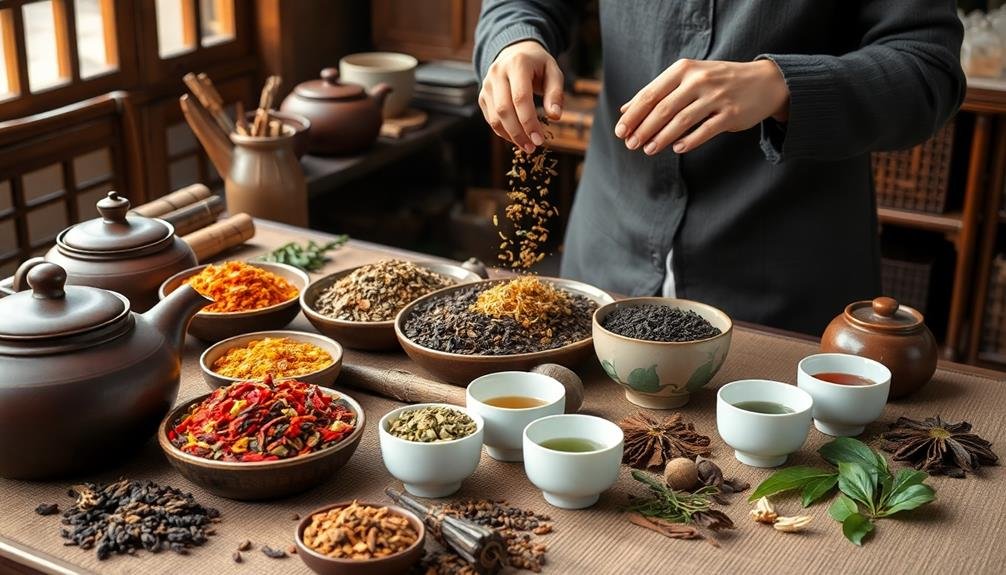
Tea leaves, like a painter's palette, offer endless possibilities for blending. You can create unique flavors by combining different types of tea leaves and herbs, enhancing both aroma and taste.
To master the art of blending, it's crucial to explore a few common techniques that will elevate your creations.
- Layering Flavors: Start with a base tea and gradually introduce complementary flavors. For instance, blend a robust black tea with a hint of floral jasmine to create depth.
- Infusion Method: You can steep various ingredients separately before combining them. This allows you to control the strength and nuances of each component, ensuring a balanced final brew.
- Trial and Error: Don't be afraid to experiment. Taste as you go, adjusting the ratios until you find the perfect harmony. Keep notes on your combinations to replicate your successes.
Proportions for Herbal Combinations
When crafting herbal combinations, understanding the right proportions is essential for revealing the full potential of your blends. Start by knowing the characteristics of each herb you're using. Some herbs are strong and can dominate the flavor, while others are subtle and may need a higher proportion to make their presence known.
A common guideline is to use a ratio of 1:2:3 for stronger, more robust herbs, like ginger or cinnamon, to milder herbs, such as chamomile or mint. For instance, if you include one part of a strong herb, consider two parts of a medium-strength herb and three parts of a milder one. This balance allows each herb to complement rather than overpower the others.
Experiment with smaller batches, adjusting the ratios based on your taste preferences. Keep notes on your combinations, so you can replicate or modify them in the future.
Seasonal Herbal Tea Blends
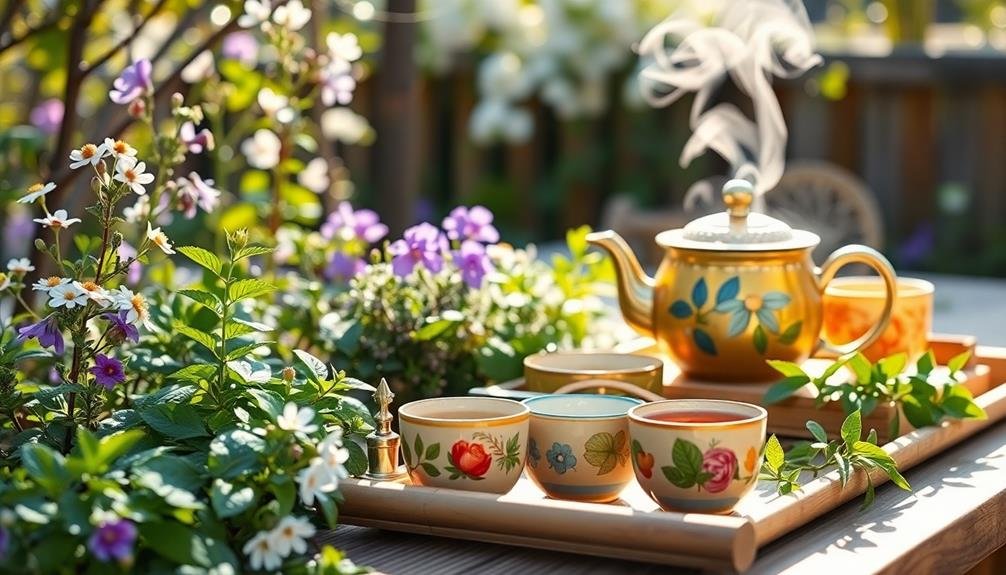
As the seasons change, so should your herbal tea blends to match the mood and benefits of each time of year.
In spring, you'll want to awaken your senses with revitalizing blends, while summer calls for light, invigorating infusions.
When autumn arrives, embrace the warmth of comforting combinations that soothe and nurture.
Spring Awakening Blends
Spring brings a burst of life and energy, making it the perfect time to explore seasonal herbal blends that awaken your senses. These blends, rich in fresh flavors and vibrant aromas, can rejuvenate your spirit and enhance your well-being.
As you commence on this journey, consider incorporating ingredients that celebrate the season's essence.
- Jasmine Blossoms: Their delicate fragrance uplifts your mood and provides calming effects.
- Lemongrass: This zesty herb invigorates your palate and aids digestion, making it an excellent addition to any blend.
- Peppermint Leaves: The cooling sensation not only revitalizes but also helps clear your mind, perfect for those sunny afternoons.
When crafting your spring awakening blends, aim for a harmonious balance. Combine the floral notes of jasmine with the citrusy zing of lemongrass and the invigorating kick of peppermint.
Experiment with different proportions to find the blend that resonates with you. This is your chance to embrace the season's renewal and energy through the art of tea blending.
Sip your creations slowly, allowing each flavor to dance on your palate and inspire a sense of rejuvenation.
Summer Refreshing Infusions
Summer is a time for revitalizing infusions that cool you down and invigorate your senses. When the heat kicks in, you'll want to blend herbs that rejuvenate and rehydrate.
Start with a base of green tea, known for its lightness and antioxidant properties. Add in dried peppermint for a cooling effect, and let its invigorating aroma awaken your palate.
You can also experiment with hibiscus, which brings a vibrant color and tart flavor, perfect for iced teas. Mix in some lemongrass to add a citrusy zing that brightens your brew. For sweetness, consider a touch of dried apple or honeybush, which balances the tartness and adds depth.
Don't forget to include a few slices of fresh cucumber or sprigs of basil; they enhance the infusion's vitality and create a delightful aromatic experience.
Steep your blend in cold water for a revitalizing iced tea, or brew it hot and chill it afterward. As you sip your summer infusion, you'll feel revitalized and ready to embrace the warmth of the season.
Enjoy discovering new combinations that suit your taste and keep you cool all summer long!
Autumn Comfort Combinations
Autumn often brings a cozy feeling that invites you to sip on warm, comforting herbal blends. As the leaves change and the air cools, you can create delightful combinations that not only warm you up but also nourish your spirit.
Embrace the season with these herbal ingredients that work harmoniously together.
- Cinnamon: Its warming properties enhance circulation and add a sweet, spicy flavor to your blend.
- Ginger: A great addition for its zest and ability to provide a soothing effect on your digestion.
- Chamomile: Known for its calming qualities, it helps ease stress while contributing a floral note.
To craft an autumn comfort tea, try blending equal parts of cinnamon and ginger with a touch of chamomile.
Steep this mixture in hot water for about 5-7 minutes, letting the aromas fill your space. You'll find that this combination not only warms you up but also brings a sense of peace and comfort.
Experiment with proportions to find your perfect blend, and don't hesitate to add a splash of honey for sweetness.
Enjoy your seasonal creation and let it wrap you in warmth!
Health Benefits of Ingredients
When you explore the world of ancient Chinese tea blending, you'll discover that each ingredient brings unique health benefits to the table.
For instance, green tea is packed with antioxidants, which can help combat oxidative stress and reduce the risk of chronic diseases. Its catechins also boost metabolism, making it a great choice if you're looking to maintain a healthy weight.
Ginger, a common addition, is renowned for its anti-inflammatory properties. It can soothe digestion, relieve nausea, and even aid in reducing muscle pain after a workout.
When you blend ginger with green tea, you create a powerful concoction that supports both digestion and overall wellness.
Chrysanthemum flowers, often used in traditional blends, are excellent for cooling the body and can help alleviate symptoms of colds or fever.
They also promote eye health and can improve skin conditions.
Tools for DIY Blending
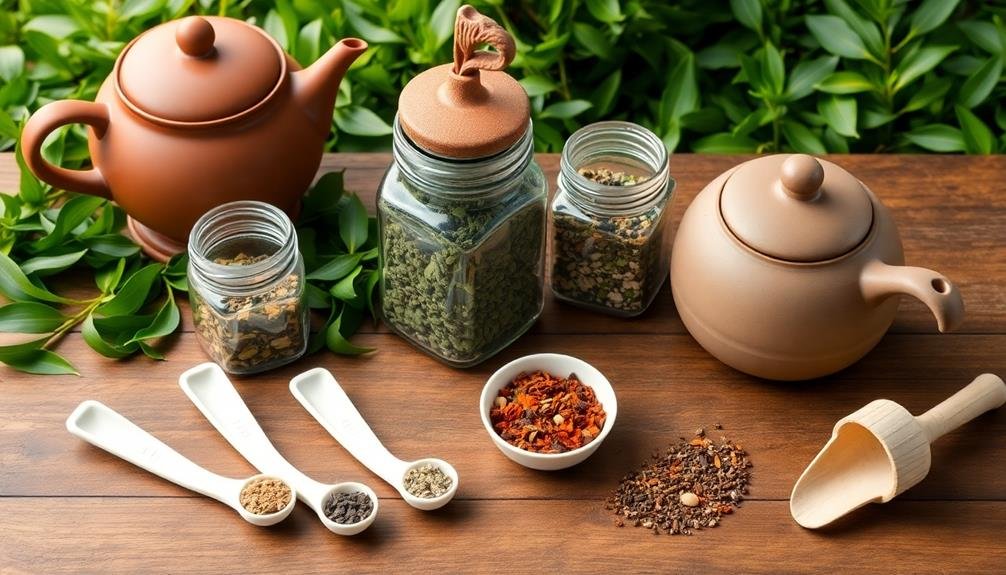
To create your own unique tea blends, having the right tools is essential.
These tools not only make the blending process easier but also help guarantee that you achieve the perfect flavor balance. Here's what you'll need:
- Digital Scale: Precision is key in blending. A digital scale helps you measure your ingredients accurately, allowing for consistent results every time you blend.
- Mortar and Pestle: This classic tool is perfect for crushing herbs and spices. By grinding them slightly, you can release their essential oils, enhancing the overall flavor profile of your blend.
- Mixing Bowl: A large mixing bowl gives you enough space to combine your ingredients thoroughly. It's also helpful for visually evaluating the blend before you brew your first cup.
With these tools at hand, you're well-equipped to experiment and create tea blends that suit your taste.
Don't hesitate to try different proportions and ingredients. As you become more comfortable, you'll develop a feel for what works together, leading you to crafting signature blends that reflect your personal palate.
Enjoy the process of exploration and creativity!
Step-by-Step Blending Guide
Creating your own tea blend can be an exciting adventure, and following a step-by-step guide will help you navigate the process with ease.
Start by gathering a variety of teas and ingredients that inspire you. Choose a base tea, like green or black, then select additional elements, such as herbal or floral notes, to complement it.
Next, measure your ingredients. A common starting ratio is 70% base tea to 30% additives. Adjust these proportions based on your taste preferences.
Once you've decided, mix your teas in a clean, dry bowl. Use your senses—smell the blend and visualize the flavor profile you want to achieve.
After blending, brew a small sample. Use a consistent steeping time and temperature to evaluate the flavor.
Take notes on what you like or dislike. If it's not perfect, tweak the ratios or try different ingredients until you achieve the desired taste.
Storage and Preservation Tips
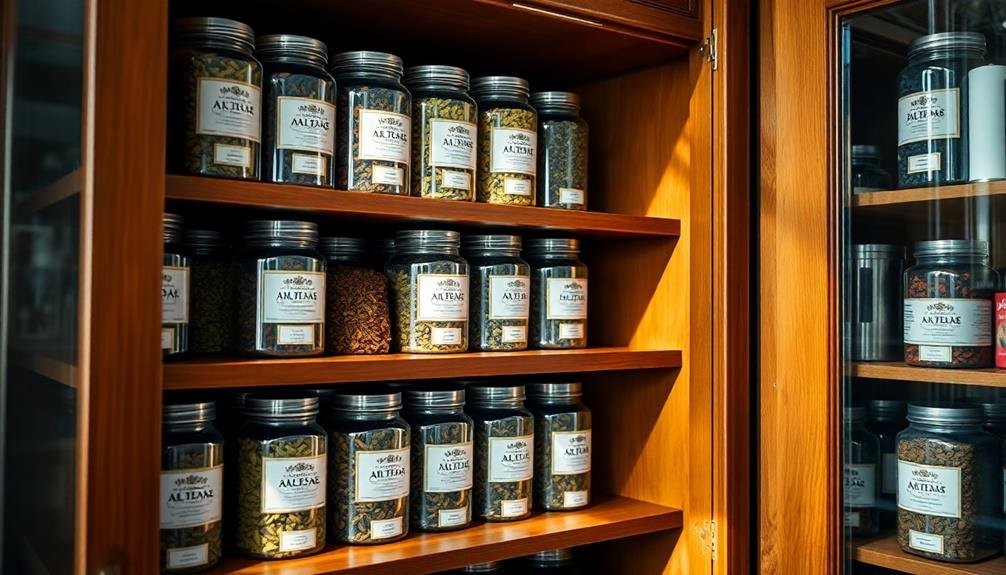
After crafting your unique tea blend, proper storage is key to maintaining its freshness and flavor. You want to protect your blend from elements that can degrade its quality, like light, moisture, and air.
Here are some effective tips to help you store your tea properly:
- Use airtight containers: Choose containers made of glass or tin that seal tightly to keep out air and moisture. Avoid plastic, as it can absorb odors and flavors.
- Keep it cool and dark: Store your tea in a cool, dark place, away from direct sunlight and heat sources. A cupboard or pantry is ideal. Temperature fluctuations can affect the flavor.
- Label your blends: Mark each container with the blend name and the date you created it. This practice helps you keep track of freshness and guarantees you enjoy your tea at its best.
Creative Blending Inspirations
Releasing your creativity in tea blending opens up a world of flavors and aromas that can elevate your tea experience.
Start by considering the base teas you enjoy, like green, black, or oolong. Each has unique characteristics that can set the stage for your blend.
Next, think about adding herbs, spices, or fruits. For instance, combine green tea with fresh mint for a revitalizing twist, or mix black tea with citrus peels for a zesty kick.
Experiment with floral notes, such as jasmine or rose, to add depth and complexity.
Don't shy away from experimenting with proportions. Start with a 3:1 ratio of base tea to additives, and adjust based on your taste preferences.
Keep a notebook to jot down your combinations and their outcomes, so you can recreate your favorites.
Frequently Asked Questions
What Are the Best Tea Blends for Beginners?
If you're starting your tea journey, try blends like Earl Grey, chai, or a fruity herbal mix. These flavors are approachable, and you'll discover what you enjoy most as you experiment with different combinations.
How Can I Enhance the Color of My Tea Blends?
To enhance the color of your tea blends, try adding vibrant ingredients like hibiscus or dried fruit. Experiment with different tea bases, and steep for varying times to achieve your desired hue and brightness.
Are There Specific Cultural Customs in Tea Blending?
Yes, there're specific customs in tea blending. You'll find that rituals often emphasize harmony and balance, reflecting respect for ingredients. Engaging in these traditions can deepen your appreciation and enhance your blending experience.
Can I Use Expired Herbs for Blending?
You shouldn't use expired herbs for blending. They lose flavor and potency, which can affect your tea's overall quality. Fresh herbs provide the best taste and health benefits, so always opt for the freshest ingredients.
What Are Common Mistakes in Tea Blending to Avoid?
When blending tea, avoid using overly strong flavors that overpower. Don't ignore balance—experiment with proportions carefully. Finally, steer clear of blending incompatible herbs; it can lead to unpleasant tastes. Trust your palate and enjoy the process!
In Summary
Now that you've explored the art of ancient Chinese tea blending, you're ready to create your own unique blends. Remember to experiment with essential herbs, balance flavors, and enjoy the process. With the right tools and techniques, you can craft brews that not only delight your taste buds but also evoke the rich history of tea. So grab your ingredients, let your creativity flow, and savor the magical world of tea blending. Happy brewing!

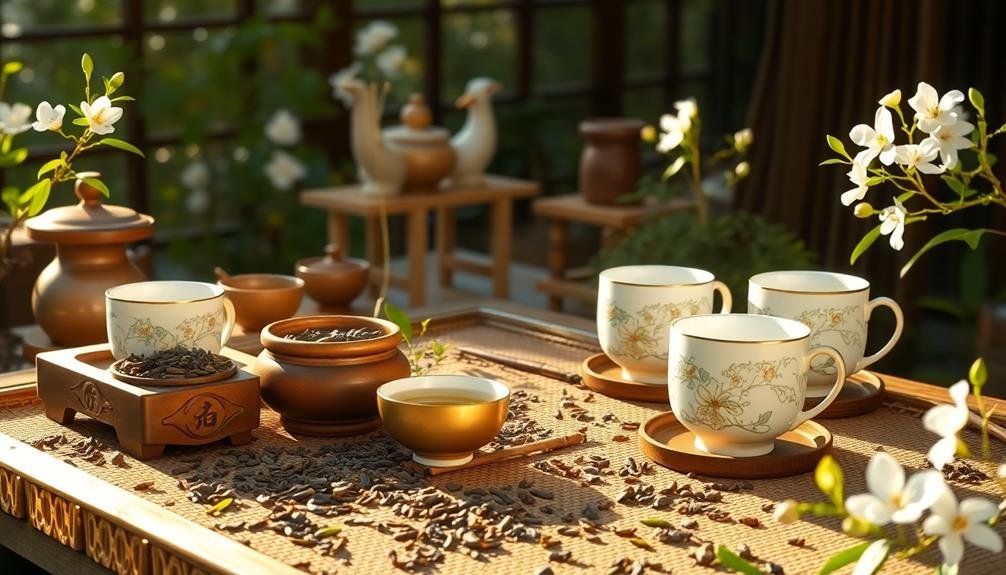
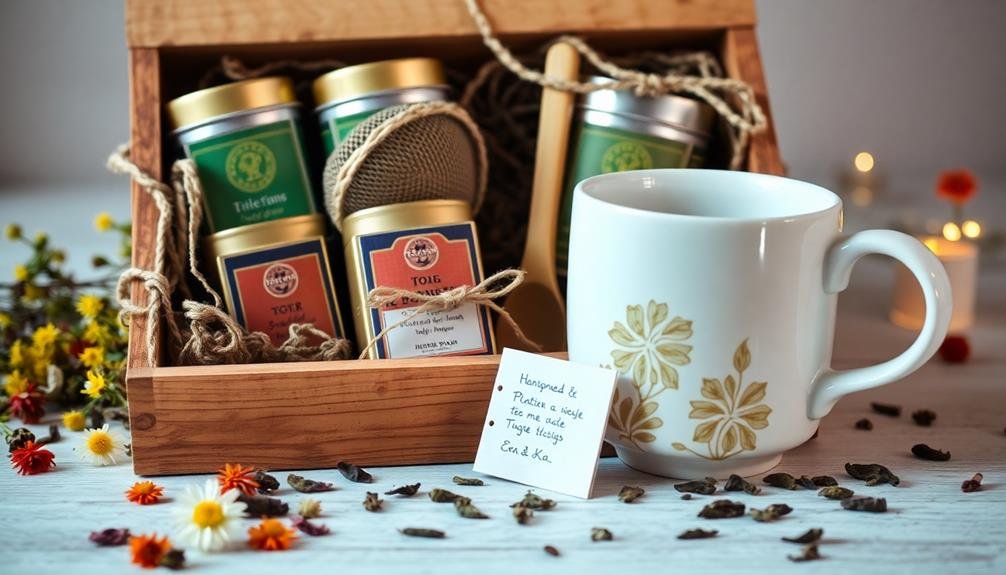
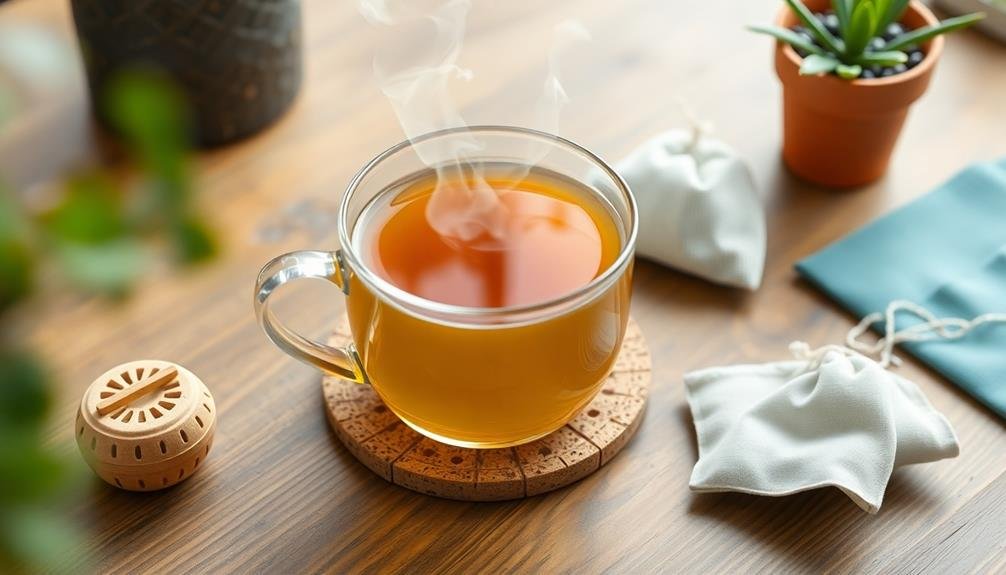
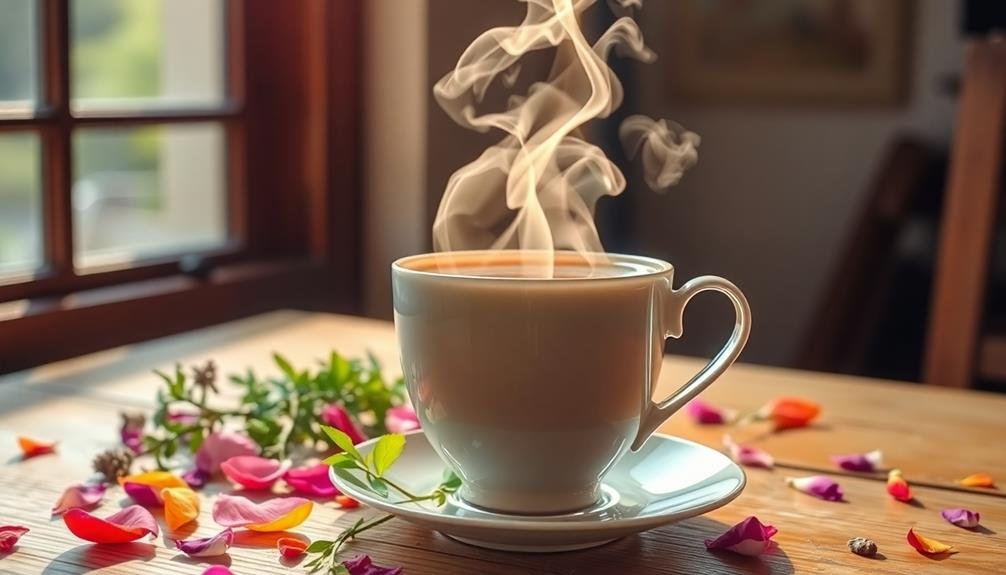
Leave a Reply